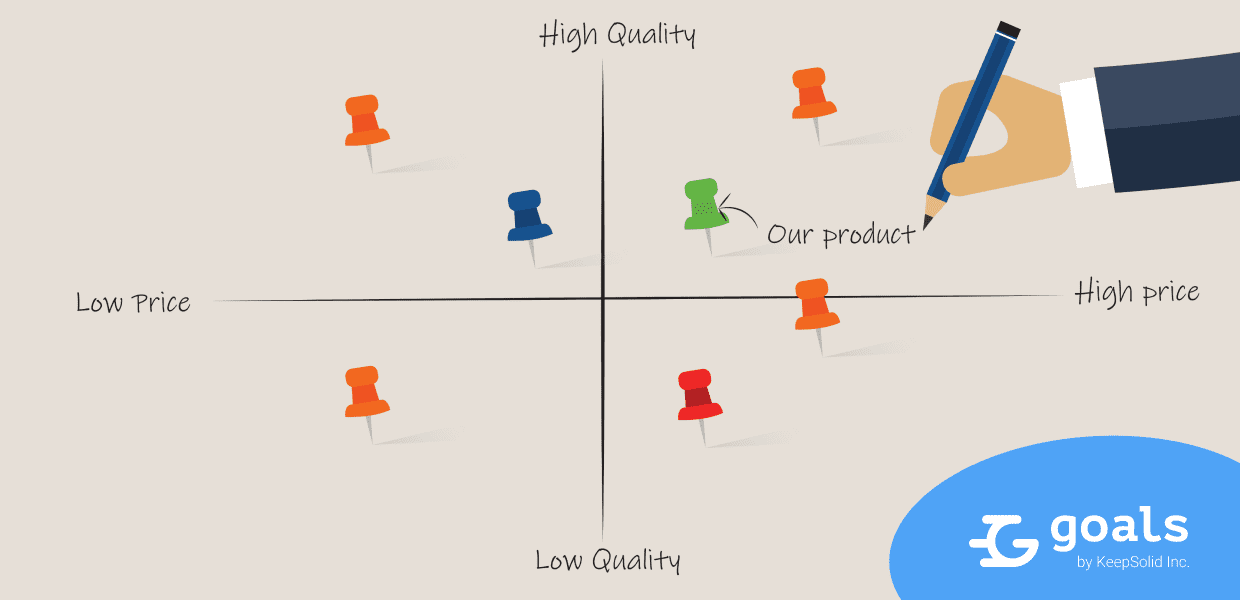What Is a Product Positioning?
Product positioning is a strategic process of defining and communicating where a product fits in the market, why it is superior to competition, and how you want the market to feel about it. Being the basis for the marketing strategy, product positioning aims at distilling the target audience, defining their needs, and shaping communication with customers to demonstrate how the product addresses those needs.

Elements of Product Positioning
Product positioning consists of several key elements designed to explain the product’s value and uniqueness:
- Vision: the product’s strategic direction
- Mission: the product’s high-level purpose
- Market category: the current market and major customer segments for the product
- Tagline: slogan used to describe the product or the brand
- Customer challenges: key customer pains
- Company/product differentiators: what makes the company or the product stand out against competitors
- Brand essence: key characteristics that make the brand recognizable.
Product Positioning Strategies
Customer perception of the product is a multi-facet feeling that consists of multiple aspects; therefore, it can be altered by emphasizing different sides and characteristics of the product forming several common strategies:
- Feature-based positioning: companies give characteristics to their products that can be associated with the overall brand image, such as performance or reliability. For example, Volvo cars will be associated with safety and will target customers who find this characteristic critical.
- Pricing-based positioning: a product is positioned as an affordable option, or the whole brand may be known as that offering products at the lowest price in the market.
- Quality or prestige-based positioning: a product or a brand is positioned as high-quality or luxury; in this case, the company relies on the reputation rather than pricing to attract and retain customers.
- Use-based positioning: a product is associated with a specific use or application targeting only a segment of the market.
- Competitor-based positioning: this strategy highlights the brand’s or the product’s superiority and advantages by comparing it – both directly and indirectly – against competition.
- Differentiation-based positioning: this strategy highlights the uniqueness of the product showing that it cannot be easily duplicated or replaced.
How to Do Product Positioning?
The goal of product positioning is to find the optimal way to present a product to target customers. To achieve this goal, you need to consider several things while building a product positioning strategy:
- Get to know the customer: the key to effective positioning is to gain a deep understanding of the target audience, their demographic or geographic characteristics, their needs, habits, fears and concerns, and what impacts them in their decisions. This is done via market research and translates into persona profiles.
- Get to know competitors: another aspect of market research is studying direct and indirect competitors to see how they address customers’ needs and what might be missing so that you can step in.
- Decide on the sentiment that your product should arise: this is the most important and difficult part. Your brand and product should arise a consistent strong and positive feeling and occupy a distinct space in customers’ minds.
- Assess your product: build product positioning on the objective product’s advantages and value it offers. For this, you can conduct a SWOT analysis to ensure that the marketing messages reflect real product experience and help users to make informed decisions as to product choice.
Product positioning is crucial in articulation of the product benefits and communicating what problem it solves to the customer, which paves the way to the product and business success.



